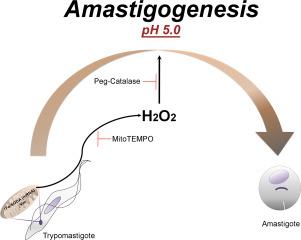Biochimica et Biophysica Acta (BBA) - Molecular Basis of Disease ( IF 4.2 ) Pub Date : 2020-08-27 , DOI: 10.1016/j.bbadis.2020.165951 Jéssica Isis Oliveira Paula 1 , Jonathan da Silva Pinto 1 , Ana Rossini 2 , Natália Pereira Nogueira 3 , Marcia Cristina Paes 3

|
Trypanosoma cruzi has a complex life cycle involving four life stages: the replicative epimastigotes and metacyclic trypomastigotes in the invertebrate host digestive tract, and intracellular amastigotes and bloodstream trypomastigotes in the mammalian host. Trypomastigotes can invade any nucleated cell, including macrophages, which produce ROS that enhance intracellular infection. However, how ROS modulate T. cruzi infection in the mammalian cell remains unclear. Therefore, the present work aimed to investigate the role of ROS during the stimulation of amastigogenesis in vitro. Our results showed that H2O2 improves the differentiation process in vitro and that it was impaired by Peg-Catalase. However, the antioxidants GSH and NAC had no influence on induced amastigogenesis, which suggests the specificity of H2O2 to increase intracellular differentiation. Amastigogenesis physiologically occurs in low pH, thus we investigated whether parasites are able to produce ROS during amastigogenesis. Interestingly, after 60 min of differentiation induction in vitro, we observed an increase in H2O2 production, which was inhibited by the mitochondrial-targeted antioxidant, mitoTEMPO and Cyclosporine A (a mitochondrial permeability transition pore -mPTP- inhibitor), suggesting mitochondrion as a H2O2 source. Indeed, quantitative real time (qPCR) showed an increase of the mitochondrial superoxide dismutase (FeSODA) gene expression after 60 min of induced amastigogenesis, reinforcing the hypothesis of mitochondrial ROS induction during intracellular differentiation of T. cruzi. The reduction of cellular respiration and the decreased ΔΨm observed during amastigogenesis can explain the increased mitochondrial ROS through mPTP opening. In conclusion, our results suggest that H2O2 is involved in the amastigogenesis of T. cruzi.
中文翻译:

过氧化氢在克氏锥虫体外形成假牙的新观点。
克氏锥虫具有复杂的生命周期,涉及四个生命阶段:无脊椎动物宿主消化道中的复制性近鞭鞭毛纲动物和元环类锥鞭毛纲生物,以及哺乳动物宿主中的胞内扁桃体和血流锥鞭大纲生物。拟鞭毛体可侵入任何有核细胞,包括巨噬细胞,这些细胞会产生可增强细胞内感染的ROS。但是,ROS如何调节哺乳动物细胞中的克鲁氏锥虫感染尚不清楚。因此,本研究旨在研究ROS在体外刺激假肢形成中的作用。我们的结果表明,H 2 O 2改善了体外分化过程并被Peg-Catalase损害。然而,抗氧化剂GSH和NAC对诱导的假牙发生没有影响,这表明H 2 O 2具有增加细胞内分化的特异性。在低pH值下生理上会发生假肢形成,因此我们研究了寄生虫是否能够在假肢形成期间产生ROS。有趣的是,在体外诱导分化60分钟后,我们观察到H 2 O 2产量增加,这受到线粒体靶向抗氧化剂,mitoTEMPO和环孢菌素A(线粒体通透性转换孔-mPTP-抑制剂)的抑制,这表明线粒体作为H 2 O 2资源。的确,定量实时(qPCR)显示诱导的乳腺增生症60分钟后线粒体超氧化物歧化酶(FeSODA)基因表达增加,从而增强了克鲁氏锥虫细胞内分化过程中线粒体ROS诱导的假说。在声像增生过程中观察到的细胞呼吸的减少和ΔΨm的降低,可以解释通过mPTP打开而增加的线粒体ROS。总之,我们的结果表明H 2 O 2参与了T. cruzi的假肢形成。











































 京公网安备 11010802027423号
京公网安备 11010802027423号